| Ghazanchetsots Cathedral shelling Սուրբ Ղազանչեցոց եկեղեցու հրթիռակոծություն | |
|---|---|
| Part of the Second Nagorno-Karabakh War | |
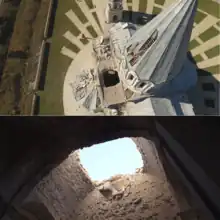 | |
| Location | Shusha, Nagorno-Karabakh |
| Date | 8 October 2020 |
| Injured | 11 |
| Perpetrator | Azerbaijani Armed Forces[1] |
The 2020 shelling of Ghazanchetsots Cathedral took place prior to the Battle of Shusha on 8 October, when the Holy Savior Cathedral (Armenian: Սուրբ Ամենափրկիչ մայր տաճար, romanized: Surb Amenap′rkich mayr tachar) of the city of Shusha, known as Ghazanchetsots Cathedral (Armenian: Ղազանչեցոց, Azerbaijani: Qazançı), was struck twice by missiles, resulting in the collapse of a part of the roof.[2][3][4] Armenia accused the Azerbaijani Armed Forces over the shelling.[5][6][7][8]
History
The shelling took place on the 11th day of the Second Nagorno-Karabakh War between Armenia and Azerbaijan, a continuation of the Nagorno-Karabakh conflict over the disputed Nagorno-Karabakh region dating from before the fall of communism.[3][9] Shusha was held by the Republic of Artsakh, an ethnic Armenian polity since the First Nagorno-Karabakh War.[3][9] In Azerbaijan, the loss of Shusha in 1992 was especially mourned as the city was the cultural centre of Azerbaijani poets, musicians, and composers.[10][11] Prior to the war, the cathedral had been damaged in ethnic violence surrounding the 1920 Shusha massacre of Armenians and then used as storehouse in the Azerbaijan Soviet Socialist Republic and in the First Nagorno-Karabakh War, until Shusha fell to the Armed Forces of Armenia in 1992.[3][9] The building was then restored in the 1990s by the Armenian Apostolic Church, which had built the church in the 1880s.[9][3]
Shelling
As reported by HRW: "On September 27, Azerbaijan launched a military offensive that escalated hostilities between Azerbaijan and Armenia and the de-facto authorities in Nagorno-Karabakh[12]". It began air and ground attacks across a number of Nagorno-Karabakh cities and settlements, including the City on Shushi: "Several attacks on Shushi were reported in the first days of fighting. By early October, many of its residents had fled, though some civilians remained, including men, women, and children".[13]
HRW and Amnesty International confirmed reports by the Armenian side [14] on the use of cluster munitions in populated areas of Shushi and other settlements of Kharabakh, resulting in civilian casualties.[12][15] Intense shelling of civilian areas of the city was also reported by international media outlets:[16][17] "At daytime, when we had half an hour without an air-raid siren, for a change, we could see the damage. The missiles of the Azerbaijani army kept hitting apartment buildings and clearly civilian targets" reported the German Bild correspondent.[18]
The Cultural House of Shushi was severely damaged by an Azerbaijani missile attack, according to media reports at the time of the attack, civilians were sheltered in the basement of the building.[19][20][21]
Shelling of the cathedral
The first shell fell on the dome of the church at 12:30 on 8 October, severely damaging the interior.[9][10] Local media reported that adults and children were sheltering inside the church when the first explosion occurred, but no-one was injured.[9] At 17:00 same day, as journalists were inspecting the damage, a second shell struck the building.[9][22] Two Russian journalists were wounded by the second strike;[23][24][25] one, the editor-in-chief of Segodnya, was critically injured and underwent surgery in Stepanakert.[9][26][27][10] An Armenian who accompanied the reporters was lightly injured.[28]
| External videos | |
|---|---|
In its subsequent report HRW specified that "Multiple factors indicate that both attacks were directed at the church. The remnants found indicate that the weapons used were capable of being directed at a specific target". Furthermore, both strikes hit the same part of the roof with a difference of less than two meters.[13]
Response
Armenia
Armenia's Foreign Ministry issued an official statement describing it as "another crime of the military-political leadership of Azerbaijan... this action fully fits into its policy of Armenophobia developed for decades. Azerbaijan, which has completely annihilated the Armenian cultural heritage in Nakhichevan and in other parts of the historical homeland of the Armenian people, now throughout the ongoing military aggression against Artsakh is trying to deprive Armenians of Artsakh of their homeland and historical memory".[29] They also stated that "With these actions Azerbaijan replicates the behavior of its newly acquired allies, infamous international terrorist organizations that are responsible for the destruction of numerous historical-cultural monuments in the Middle East".[26] Artsrun Hovhannisyan, spokesman of the defence ministry of Armenia, blamed the shelling on "enemy Azerbaijan".[2]
According to Armenpress, Pargev Martirosyan, the bishop of the Diocese of Artsakh of which the cathedral is the episcopal see, compared the shelling with the actions of Islamic State of Iraq and the Levant, saying "They are bombarding our spiritual values, when we are restoring and preserving mosques".[30][10] Another priest at the cathedral said "I feel the pain that the walls of our beautiful cathedral are destroyed. I feel the pain that today the world does not react to what's happening here and that our boys are dying defending our Motherland".[10]
After the shelling, the Belgian- Armenian cellist Sevak Avanesyan playing the damaged building. He played the piece "Stork" (Armenian: Krunk) by the Armenian composer Komitas, who was a victim of the Armenian genocide.[10][31] The video was posted on October 12 on Armenia's official Twitter account, which according to Al-Jazeera, was a message that the cathedral's shelling by Azerbaijan was part and parcel of a centuries-old enmity of Turks towards Armenians.[31]
Azerbaijan
Azerbaijan's Defense Ministry officially denied involvement,[32] while the Azerbaijan state news agency claimed Armenia was behind the attack.[33]
In an interview with BBC News journalist Orla Guerin, the President of Azerbaijan, Ilham Aliyev, denied the church was a military target for his forces and said that the shelling was "either it was a mistake of our artillery or it was a deliberate provocation by Armenians themselves".[34]
On Russia 1 TV show Evening with Vladimir Solovyov, Azerbaijani journalist and political analyst, Saadat Kadyrova, justified the shelling of the church since the Armenian armed forces were praying in the building.[35]
International
A statement released by the International Association of Genocide Scholars (IAGS), signed by Israel Charny, Yair Auron, Matthias Bjørnlund, Tessa Hofmann and others condemned intentional attacks of civilians and civilian infrastructures by Azerbaijani forces, describing the strikes on the church as "part of policy of the cultural genocide that the Azerbaijani government has been implementing over the past 30 years by systematically destroying the Armenian historical heritage.".[36]
World Monuments Fund condemned the targeting of the cathedral, stating that it "considers absolutely unacceptable any willful destruction of cultural heritage" [37][38]
Human Rights Watch's Europe and Central Asia director Hugh Williamson called on Azerbaijan to investigate the attacks: "It has been over a month since Azerbaijan has retaken control of Shusha and the government needs to waste no time in investigating the attacks and holding those responsible to account. Attacks such as these serve no military purpose and all parties should ensure these kinds of attacks are punished and otherwise prevented."[39][40]
Aftermath
Azerbaijani forces seized control of Shusha on 7 November, after a three-day long battle over the city.[41][42][43] On 10 November, a ceasefire agreement was reached between Armenia and Azerbaijan with Russia's mediation.[43][44]
After Azerbaijan's seizure the remaining Armenian population fled the city, while multiple reports started emerging that Armenian cultural heritage was being vandalised and destroyed across the territories under Azerbaijani control.[45][46][47][48][49][50] Among others, videos and photos of vandalized Ghazanchetsots Cathedral and partially destroyed Kanach Zham church[51][52] were posted on social media. The Armenian Foreign Ministry and the Armenian Apostolic Church issued statements condemning these acts.[53][54][55]
A number of scholars and cultural Institutions, like the Metropolitan Museum of Art, issued pleas for the preservation of cultural heritage in Nagorno-Karabakh, expressing concern and advocating for renewed protection of Armenian cultural heritage in the region.[56][57]
On 20 November 2021, the UNESCO Director-General Audrey Azoulay declared the necessity of protecting the monuments of Nagorno-Karabakh and the inadmissibility of attempts to distort their identity. She offered to send an independent mission of experts to Nagorno-Karabakh and surrounding districts to draw a preliminary inventory of significant cultural properties.[58] The proposal was approved by the member states, reflecting the Declaration of the UNESCO Committee for the Protection of Cultural Property in the Event of Armed Conflict.[59] However Azerbaijan did not grant access to the territories, accusing UNESCO of being "bias" and using "double standards".[60][61]
On 3 May 2021, Armenian sources began reporting that the dome and the cross of Ghazanchetsots Cathedral had been removed. After an outcry from the Armenia side, Azerbaijani authorities issued a statement saying the cathedral was under reconstruction to "restore" its "original" form, without specifying what they intended by the "original" style.[62] The Armenian Foreign Ministry called these actions of Azerbaijan "deplorable" and an act of "vandalism aimed at depriving the Shushi Cathedral of its Armenian identity."[63][64][65]
The USCIRF also expressed concern, stating that it was "troubled by reports concerning the preservation and integrity of houses of worship and other religious sites— such as the Armenian Apostolic Ghazanchetsots Cathedral in Shusha, which appears to have had its domes removed amid reports of its 'restoration' without the input of its congregation,".[66] USCIRF Commissioner Nadine Maenza added that "While the cathedral is certainly in need of repair following the damage it endured as a result of Azerbaijani shelling last fall, it is imperative that it and other sites are properly restored and maintained."[67] In its 2020 Annual Report USCIRF also recommended that the U.S. Department of State place Azerbaijan on its Special Watch List for its ongoing and systematic religious freedom violations.[68] In its 2021 Annual Report USCIRF reiterated that "Over the course of the fighting and in the immediate aftermath of the November ceasefire, numerous local and international observers raised concerns about safeguarding religious and other cultural sites, specifically underscoring the need to protect the various Armenian churches, monasteries, and cemeteries lost or subsequently ceded to Azerbaijani control."[69]
In a court hearing at the ECHR on October 15, 2020, the Armenian side presented, among other things, evidence of the shelling of the cathedral and Azerbaijan's subsequent treatment of it.[70] On December 7, 2020, the court upheld the interim measures requested by Armenia to ensure that Azerbaijan prevented "vandalism and desecration" of the Armenian cultural heritage located in the territories controlled by Baku.[71][72][73]
In March 2022 the European Parliament adopted a joint resolution condemning the destruction of Armenian Heritage in Nagorno- Kharabakh, including the destruction caused during and after the shelling of Ghazanchetsots Cathedral.[74]
Currently the cathedral is completely covered by scaffolding and mesh.[75] No independent international experts have been able to inspect the site as Azerbaijan continues to deny access to the UNESCO mission.[76]
Gallery
 Armenian wedding in damaged Holy Savior Cathedral on 24 October 2020
Armenian wedding in damaged Holy Savior Cathedral on 24 October 2020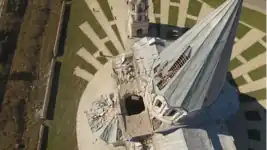 The roof of the damaged Ghazanchetsots Cathedral
The roof of the damaged Ghazanchetsots Cathedral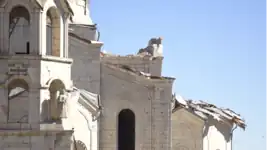 Damaged part of the Ghazanchetsots Cathedral
Damaged part of the Ghazanchetsots Cathedral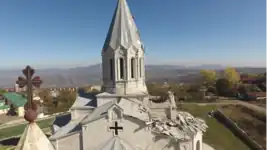 Damaged Ghazanchetsots
Damaged Ghazanchetsots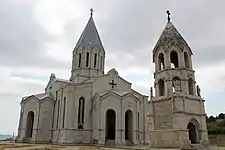 The Ghazanchetsots Cathedral before the shelling
The Ghazanchetsots Cathedral before the shelling
See also
Notes
References
- ↑ "Church bombed to ruins - Journalists were injured during second attack – one of them is fighting for his life". 12 October 2015. Archived from the original on 2020-10-10.
- 1 2 "Nagorno-Karabakh: Armenia accuses Azerbaijan of shelling Shusha cathedral". BBC News. 8 October 2020. Archived from the original on 8 October 2020.
- 1 2 3 4 5 Demourian, Avet (2020-10-08). "Armenia says cathedral shelled in clashes with Azerbaijan". Associated Press. Retrieved 2020-11-10.
- ↑ "Church bombed to ruins - Journalists were injured during second attack – one of them is fighting for his life". bild.de. BILD.de. 8 October 2020. Archived from the original on 10 October 2020.
- ↑ "Armenia accuses Azerbaijan of shelling historic cathedral in Nagorno-Karabakh". Los Angeles Times. 2020-10-08. Retrieved 2021-04-13.
- ↑ "Armenia accuses Azerbaijan of shelling historic cathedral amid conflict". Global News. Retrieved 2021-04-13.
- ↑ "В Нагорном Карабахе разбомбили собор Казанчецоц". Strelka Mag (in Russian). Archived from the original on 2021-04-13. Retrieved 2021-04-13.
- ↑ "В Армении заявили, что азербайджанские ВС разбомбили собор Казанчецоц в Карабахе". ТАСС. Retrieved 2021-04-14.
- 1 2 3 4 5 6 7 8 "Nagorno-Karabakh: Armenia claims cathedral hit by Azerbaijan shelling". Deutsche Welle. 2020-10-08. Retrieved 2020-11-10.
- 1 2 3 4 5 6 "Cellist plays to mourn cathedral shelled in Armenia-Azerbaijan conflict". Classic FM. Retrieved 2020-11-10.
- ↑ Freeman, Colin (2020-10-08). "Steeped in blood: the hilltop town at centre of the ethnic feud between Azerbaijan and Armenia". The Telegraph. ISSN 0307-1235. Retrieved 2020-11-10.
- 1 2 "World Report 2021: Rights Trends in Azerbaijan". Human Rights Watch. 2020-12-10. Retrieved 2021-07-24.
- 1 2 "Azerbaijan: Attack on Church Possible War Crime". Human Rights Watch. 2020-12-16. Retrieved 2021-04-17.
- ↑ "Azerbaijan fired cluster munitions on Shushi, Karabakh Ombudsman says". www.newsinfo.am. Retrieved 2021-07-24.
- ↑ "Armenia/Azerbaijan: Civilians must be protected from use of banned cluster bombs". www.amnesty.org. 5 October 2020. Retrieved 2021-07-24.
- ↑ Узел, Кавказский. "Shushi resident killed in a shelling attack". Caucasian Knot. Retrieved 2021-07-24.
- ↑ "Nagorno-Karabakh: Key cities targeted in Armenian, Azeri shelling". www.aljazeera.com. Retrieved 2021-07-24.
- ↑ Ronzheimer, Paul (2020-11-10). "We have watched this war happen". bild.de (in German). Retrieved 2021-07-24.
- ↑ "Azerbaijan Targets Armenian Church And Cultural House In Artsakh (VIDEO) — Greek City Times". 9 October 2020. Retrieved 2021-07-24.
- ↑ "Разрушен дом культуры: последствия обстрела города Шуши в Карабахе". РЕН ТВ (in Russian). 2020-10-06. Retrieved 2021-07-24.
- ↑ Черников, Валентин (7 October 2020). "Видео: в Нагорном Карабахе разбомбили дом культуры". Пятый канал (in Russian). Retrieved 2021-07-24.
- ↑ AFP, GEO avec (2020-10-08). "Haut-Karabakh : une cathédrale historique arménienne touchée par des bombardements". Geo.fr (in French). Retrieved 2022-01-22.
- ↑ "Российские журналисты пострадали при обстреле церкви в Карабахе". РИА Новости (in Russian). 2020-10-08. Retrieved 2021-04-14.
- ↑ Светлана, Кравчук (2020-10-08). "Удар по храму: в Карабахе пострадали журналисты из России". Газета.Ru (in Russian). Retrieved 2021-04-14.
- ↑ "Пострадавших в Карабахе российских журналистов вывезут спецбортом". РБК (in Russian). 9 October 2020. Retrieved 2021-04-14.
- 1 2 "Church bombed to ruins - Journalists were injured during second attack – one of them is fighting for his life". azatutyun.am. BILD.de. 8 October 2020. Archived from the original on 8 October 2020.
- ↑ "Russian blogger Yuri Kotenok heavily injured in Shushi, says Armenian Foreign Ministry". TASS. Retrieved 2020-11-10.
- ↑ "Another Journalist Wounded In Karabakh". archive.vn. 2020-10-08. Archived from the original on 2020-10-08. Retrieved 2020-11-10.
- ↑ "The statement of the Foreign Ministry of the Republic of Armenia regarding the targeting of the places of religious worship and cultural monuments in Shushi". 8 October 2020. Retrieved 19 October 2020.
- ↑ "They bomb our churches, we preserve mosques – Archbishop on Azeri "ISIS-style" attack in Artsakh". armenpress.am. Retrieved 2020-11-10.
- 1 2 Mirovalev, Mansur (2020-10-15). "Armenia, Azerbaijan battle an online war over Nagorno-Karabakh". Al Jazeera. Retrieved 2020-11-10.
- ↑ @wwwmodgovaz (October 8, 2020). "#Azerbaijan Army does not target the historical/cultural/ religious buildings and #monuments. This is No. Armenia, which hit Imamzade #religious complex on 4th OCT 2020. The claim about Azerbaijan Army's strike on the church in Shusha is unfounded" (Tweet) – via Twitter.
- ↑ "Şuşadakı kilsəyə guya raket zərbəsinin endirilməsi ilə bağlı feyk xəbərlərin yayılması Ermənistanın növbəti təxribatıdır". azertag.az. Azerbaijan State News Agency. 8 October 2020. Archived from the original on 9 October 2020.
- ↑ "Nagorno-Karabakh: President Ilham Aliyev speaks to the BBC". BBC News. 2020-11-09. Retrieved 2020-11-10.
- ↑ "Азербайджанка сравнила храм в Шуши с "сортиром" в эфире у Соловьева". discover24.ru (in Russian). 2020-10-09. Retrieved 2021-12-30.
- ↑ "IAGS members see imminent genocidal threat deriving from Azerbaijan and Turkey against Artsakh". Armenpress. 22 October 2020. Archived from the original on 22 October 2020. Retrieved 22 October 2020.
- ↑ LLC, Helix Consulting. "World Monuments Fund condemns targeting of Shusha's Ghazanchetsots Cathedral". www.panorama.am. Retrieved 2022-01-23.
- ↑ "World Monuments Fund - Facebook statement". Facebook. 9 October 2020. Archived from the original on 2022-01-23. Retrieved 2022-01-23.
- ↑ "Azerbaijan: Attack on Church Possible War Crime". www.hrw.org. Retrieved 2021-08-16.
- ↑ "International Association of Genocide Scholars Statement on Imminent Genocidal Threat Against Artsakh". MassisPost. 2020-10-31. Archived from the original on 2020-11-01. Retrieved 2021-08-16.
- ↑ "Nagorno-Karabakh: Azerbaijan 'takes key town' in Armenia conflict". BBC News. 2020-11-08. Retrieved 2020-11-10.
- ↑ "Nagorno-Karabakh confirms Azerbaijani forces have taken control of key city". The Independent. 2020-11-09. Archived from the original on 2020-11-09. Retrieved 2020-11-10.
- 1 2 Losh, Jack (2020-11-10). "Angry mob storms Armenia parliament after PM agrees Nagorno-Karabakh deal". The Guardian. ISSN 0261-3077. Retrieved 2020-11-10.
- ↑ Demourian, Avet (2020-11-09). "Armenia, Azerbaijan agree to end fight in Nagorno-Karabakh". Associated Press. Retrieved 2020-11-10.
- ↑ Lori Khatchadourian; Ian Lindsay; Adam T. Smith (June 2021). "Caucasus Heritage Watch: Monitoring Report #1". Cornell Institute of Archaeology and Material Studies: Cornell University. p. 19. Archived from the original on 2021-07-07. Retrieved November 4, 2021.
In sum, there are real and present threats to the integrity of the heritage landscape of Nagorno Karabakh that result from a range of factors from development work undertaken without sufficient attention to heritage sites to intentional acts against Armenian monuments.
- ↑ Maranci, Christina (15 December 2020). "Armenians displaced from Nagorno-Karabakh fear their medieval churches will be destroyed". The Conversation. Archived from the original on 22 January 2021. Retrieved 2021-01-24.
- ↑ Artsakh ombudsman (26 January 2021). "AD HOC PUBLIC REPORT THE ARMENIAN CULTURAL HERITAGE IN ARTSAKH (NAGORNO-KARABAKH): CASES OF VANDALISM AND AT RISK OF DESTRUCTION BY AZERBAIJAN". artsakhombuds.am. Archived from the original on 2021-12-05. Retrieved 23 November 2021.
- ↑ "Destruction of Crosses and desecration of churches". azeriwarcrimes.org. 11 January 2021. Archived from the original on 2021-02-11. Retrieved 3 December 2021.
- ↑ "Why did this church disappear?". BBC News. Retrieved 2021-12-04.
- ↑ Transparency International Anticorruption Center (February 28, 2021). "Report on Xenophobia in Azerbaijan" (PDF). Archived (PDF) from the original on 2021-03-10.
- ↑ "REPORT: Azerbaijanis Have Destroyed The Bell Tower & Dome Of Shushi's Armenian "Kanach Zham" Church, Built In 1818. – ZARTONK MEDIA". zartonkmedia.com. Retrieved 2021-12-02.
- ↑ "The Kanach Zham Church in Shushi has been partially destroyed". FIP.AM. 2020-11-19. Retrieved 2021-12-02.
- ↑ Узел, Кавказский. "Армянская церковь заявила об осквернении собора в Шуши". Кавказский Узел. Archived from the original on 14 November 2020. Retrieved 2020-11-16.
- ↑ "Армянская церковь обвинила азербайджанцев в осквернении собора в Шуши". РБК (in Russian). 15 November 2020. Archived from the original on 16 November 2020. Retrieved 2020-11-16.
- ↑ "Statement of the Ministry of Foreign Affairs of the Republic of Armenia on the act of vandalism of the Holy Savior Ghazanchetsots Church in Shushi". www.mfa.am (in Armenian). Retrieved 2021-11-23.
- ↑ McGreevy, Nora (24 November 2020). "Why Scholars, Cultural Institutions Are Calling to Protect Armenian Heritage". Smithsonian Magazine. Archived from the original on 2020-11-24. Retrieved 2021-11-23.
- ↑ "Statement from The Met on Armenian Cultural Heritage Sites". www.metmuseum.org. 17 November 2020. Archived from the original on 2020-11-17. Retrieved 2021-11-23.
- ↑ O'Hagan, Clare (2020-11-20). "Nagorno-Karabakh: Reaffirming the obligation to protect cultural goods, UNESCO proposes sending a mission to the field to all parties". UNESCO. Retrieved 2021-12-02.
- ↑ UNESCO (11 December 2020). "Declaration of the Committee for the Protection of Cultural Property in the Event of Armed Conflict of the Second Protocol to The Hague Convention of 1954 for the Protection of Cultural Property in the Event of Armed Conflict – ensuring cultural property protection in and around Nagorno-Karabakh and setting-up an independent technical mission" (PDF). en.unesco.org. Archived (PDF) from the original on 2020-12-15. Retrieved 3 December 2021.
- ↑ "Azerbaijan upset with UNESCO's biased statement after Karabakh war – Minister of Culture". Trend.Az. 2021-01-14. Retrieved 2021-12-04.
- ↑ "Aliyev threatens UNESCO 'with revision of relations', claims org works for 'Armenian lobby' - JAMnews". English Jamnews. 2021-01-05. Retrieved 2021-12-04.
- ↑ "Azerbaijan begins controversial renovation of Armenian church | Eurasianet". eurasianet.org. Retrieved 2021-12-05.
- ↑ Kucera, Joshua (7 May 2021). "Azerbaijan begins controversial renovation of Armenian church". Eurasianet. Archived from the original on 5 October 2021. Retrieved 6 October 2021.
- ↑ "Armenian Foreign Ministry Decries Azerbaijani Mutilation of Shushi Ghazanchetsots Cathedral". hetq.am. 4 May 2021. Archived from the original on 7 September 2021. Retrieved 7 September 2021.
The actions being carried out by Azerbaijan at the Ghazanchetsots Cathedral of the Holy Savior in Shushi are deplorable, as there are already many precedents for the destruction of Armenian places of worship, monuments, as well as for justification of such actions. Armenia's Ministry of Foreign Affairs
- ↑ ռ/կ, Ազատություն (4 May 2021). "Armenia Condemns Azeri 'Destruction' Of Karabakh Church". «Ազատ Եվրոպա/Ազատություն» ռադիոկայան (in Armenian). Retrieved 2021-11-23.
- ↑ "USCIRF Concerned by Azerbaijan Religion Law Amendments, Condition of Ghazanchetsots Cathedral | USCIRF". www.uscirf.gov. 2021-12-02. Archived from the original on 2021-05-17. Retrieved 2021-12-02.
- ↑ "USCIRF Releases Country Update on Azerbaijan | USCIRF". www.uscirf.gov. 2021-12-02. Archived from the original on 2021-03-18. Retrieved 2021-12-02.
- ↑ USCIRF, ANNUAL REPORT 2020. "AZERBAIJAN – RECOMMENDED FOR SPECIAL WATCH LIST" (PDF). www.uscirf.gov. Archived (PDF) from the original on 2020-05-10. Retrieved 2 December 2021.
{{cite web}}: CS1 maint: numeric names: authors list (link) - ↑ USCIRF (2021). "UNITED STATES COMMISSION ON INTERNATIONAL RELIGIOUS FREEDOM - ANNUAL REPORT 2021" (PDF). www.uscirf.gov. Archived (PDF) from the original on 2021-04-21. Retrieved 23 November 2021.
- ↑ "VERBATIM RECORD - in the case concerning Application of the International Convention on the Elimination of All Forms of Racial Discrimination (Armenia v. Azerbaijan)" (PDF). www.icj-cij.org. Европейский суд по правам человека. 15 October 2020.
- ↑ ECHR (7 December 2020). "APPLICATION DE LA CONVENTION INTERNATIONALE SUR L'ÉLIMINATION DE TOUTES LES FORMES DE DISCRIMINATION RACIALE (ARMÉNIE c. AZERBAÏDJAN)" (PDF). www.icj-cij.org (in French).
- ↑ "Суд ООН потребовал от Азербайджана и Армении положить конец разжиганию расовой ненависти". RFI (in Russian). 2021-12-07. Retrieved 2021-12-30.
- ↑ "Cultural Desecration Is Racial Discrimination". Foreign Policy. 13 January 2022. Archived from the original on 2022-01-13. Retrieved 2022-01-13.
- ↑ "JOINT MOTION FOR A RESOLUTION on the destruction of cultural heritage in Nagorno-Karabakh". www.europarl.europa.eu. Retrieved 2022-04-05.
- ↑ "Ադրբեջանցիները ծածկել են Շուշիի Սուրբ Ղազանչեցոց եկեղեցին". www.7or.am. Retrieved 2021-12-05.
- ↑ Amelan, Roni (2020-12-21). "UNESCO is awaiting Azerbaijan's Response regarding Nagorno-Karabakh mission". UNESCO. Retrieved 2021-12-02.